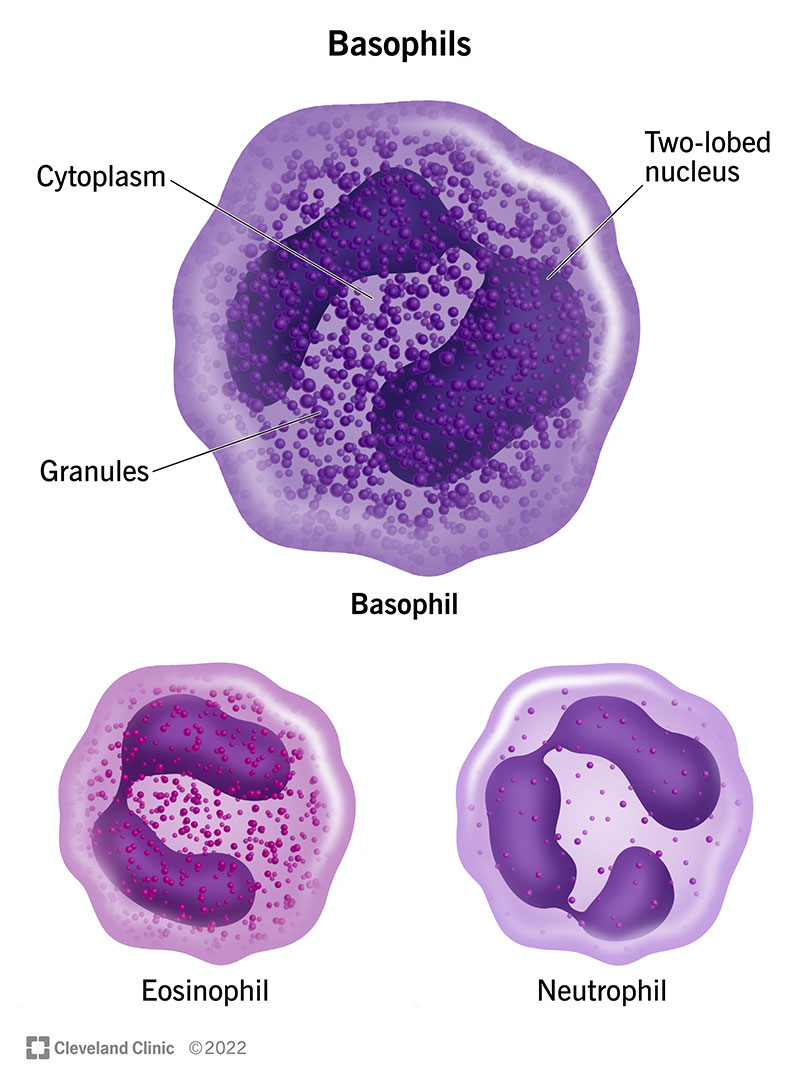Basophils are a type of white blood cell in your immune system that help defend your body from allergens, pathogens and parasites. Basophils release histamine to improve blood flow to damaged tissue and heparin to prevent unwanted blood clots. Abnormal basophil levels may indicate various conditions, from allergic reactions to cancer.
Advertisement
Cleveland Clinic is a non-profit academic medical center. Advertising on our site helps support our mission. We do not endorse non-Cleveland Clinic products or services. Policy

Basophils are white blood cells in your immune system that protect your body from infections and allergens. They’re also one of three types of granulocytes. Compared to the other two types of granulocytes in your blood — neutrophils and eosinophils — basophils are the fewest in number but the largest in size.
Advertisement
Cleveland Clinic is a non-profit academic medical center. Advertising on our site helps support our mission. We do not endorse non-Cleveland Clinic products or services. Policy
Basophils play an especially important role in helping your body fight allergens. Symptoms like itchy skin, a runny nose and watery eyes are signs that basophils are working to get rid of a foreign substance in your body.
Basophils have several functions. They:
Basophils are different from some other types of white blood cells in that they don’t recognize foreign organisms (pathogens) they've already been exposed to. Instead, they attack any organism they find that’s unfamiliar to your body. Basophils destroy these invaders by surrounding and ingesting them (phagocytosis).
Basophils form in the soft tissue inside your bones (bone marrow). After they mature, they travel through your bloodstream until they reach damaged tissues. They help heal the area.
Basophils are microscopic cells that are spherical in shape. They have a two-lobed nucleus (which looks like two raindrops connected by a thin thread). To view these cells under a microscope, a lab technician adds a stain or dye to the sample of cells. This makes the cells turn a shade of purple to black. It causes the granules inside to appear as tiny purple polka dots.
Advertisement
Basophils make up less than 1% of all of your white blood cells, making them the least common type. In a blood test, a normal basophil count is .5% to 1% of your total white blood cells. This equals about 0 to 300 basophils per microliter of blood in healthy adults.
A basophil count outside of this range means you may have a basophil-related condition.
Two types of conditions affect your basophils:
In both cases, your healthcare provider may need to run tests to determine what’s causing your basophil counts to be outside the normal range.
There aren’t any direct symptoms associated with an abnormal basophil count. Any symptoms you experience are a sign of an underlying medical condition.
Symptoms of conditions that affect your basophils include:
As basophils are a type of white blood cell, your healthcare provider will order a complete blood count (CBC) with differential. This test counts all the types of white blood cells in a blood sample to check whether your white blood cell count is too high, normal or too low.
An absolute basophil count (ABC) identifies how many basophils specifically are present in a blood sample. The calculation multiplies the percentage of basophils from a CBC by the total number of white blood cells in the same count.
Abnormal basophil levels may indicate a condition, but your healthcare provider will need to do more tests to confirm a diagnosis.
Treatments for conditions that affect your basophils include:
You can keep your basophils healthy by:
It’s not better to have high basophils rather than low basophils — or vice versa. Both may be a sign of a long-term condition that requires ongoing treatment. Or the abnormal levels may be a sign of something that is easier to address, like a medication side effect. Your healthcare provider will do more investigating to be sure.
Advertisement
When allergy season strikes, your runny nose and watery eyes indicate that your basophils are doing their job. Your healthcare provider will suggest an absolute basophil count (ABC) to check for cell abnormalities. This may be the first step your provider takes toward diagnosing an underlying medical condition or recommending treatment options for persistent allergies or infections.
Advertisement
When you want expert blood disorder care, look no further than Cleveland Clinic. Our hematology experts offer personalized care and support.

Last reviewed on 11/04/2024.
Learn more about the Health Library and our editorial process.